Revive old WordPress posts with AI and Uncanny Automator. Learn how to reverse content decay…
6+ Heroic Knowledge Base Automations That Will Revolutionize Your Customer Support
Discover 6+ Heroic Knowledge Base automations that will change the way you work. Integrate AI into your customer support workflows, turn tickets into articles, and more with Automator.
Did you know that almost 9 out of 10 Millennials (those born between 1981 and 1996) turn to search engines for answers before reaching out to customer support?
That means if your knowledge base isn’t optimized to provide fast, accurate solutions, you might be frustrating your customers before they even submit a support ticket.
However, with the right tools, your support documentation can write itself.
Imagine automatically tracking an article’s performance to optimize FAQ sections. Or how about converting customer inquiries into helpful documentation? And why not power your knowledge base with AI?
By automating key processes like these, you can create a self-service customer support system that has all of the answers at all of the right times. Not only will your customers find answers faster, but your support team will spend less time responding to the same queries over and over again.
In this guide, we’ll walk you through 6+ Heroic Knowledge Base automations that will revolutionize the way you work. The best part? You can implement most of these automations for free with Uncanny Automator. You won’t even have to write a single line of code.
Let’s dive in.
Why Automate Heroic Knowledge Base?
No matter how smart your knowledge base is, it can always be smarter.
Even if your knowledge base articles are clear and well-written, you still need to keep them updated and fresh. Additionally, your customers might not always know exactly what they’re looking for.
And if they’re not getting the information they need? Your support team is the next stop—leading to higher ticket volumes and longer response times.
By automating Heroic Knowledge Base, you can:
- Provide faster, more efficient support: Automatically route customer feedback, generate AI-powered suggestions, and streamline ticket escalation.
- Improve content quality: Track article effectiveness in real-time and flag outdated content for review.
- Reduce manual work: Eliminate repetitive tasks by converting customer interactions into actionable insights and new content.
Think of automation like hiring an extra support agent who works behind the scenes, ensuring that customers always have access to the most relevant, up-to-date information.With Uncanny Automator, setting up workflows that support your customer support team takes just a few clicks and even fewer minutes.
Get your Automator Pro license now >>>
In the next sections, we’ll explore six strategies for automating Heroic Knowledge Base that will absolutely change the way you work.
Automating Knowledge Base Analytics
Did you know that 57% of customer support calls come from users who already tried to find answers on a company’s website? This means that a significant portion of support tickets could be avoided if businesses had better knowledge base insights.
Moreover, businesses that track their customers’ usage of their knowledge base can get a headstart when answering calls and replying to tickets.
Here are two simple but yet highly effective ways to track your knowledge base articles’ performance.
1. Capture & Analyze Article Performance Automatically
When customers upvote an article, it’s a clear sign that your documentation is working as intended. On the other hand, when they downvote an article, it means that your documentation missed its mark.
Heroic Knowledge Base (HKB) already keeps track of your articles’ views and votes. However, with Uncanny Automator, you can track important additional information with the use of tokens (dynamic data from your WordPress website and from within recipes). You can then use this additional information (such as user IDs, dates and time, articles tags and categories, etc.) to contextualize the raw data you get from HKB.
By analyzing more detailed data like this, your team can prioritize which articles need improvement, reducing unnecessary support inquiries. Furthermore, the insights you glean from this data can help you optimize your knowledge base content in the future.
Connect Heroic Knowledge Base to Google Sheets >>>
2. Track Customer KB Article Usage
Imagine if one of your regular customers couldn’t resolve their issue from one of your knowledge base articles and reached out to your support team. Or, perhaps, they were able to resolve their issue but still needed additional support.
With automation, when this customer opened a ticket or picked up the phone, your support team could see exactly which HKB articles the customer saw, when, and could read the comments they left.
That’s the idea behind the Automator recipe pictured above. Providing your support team with this additional information can help them better understand where the customer is along their journey and what kind of assistance they need.
Give your customer support team the power of automation >>>
Integrating HKB Automations with Customer Support & AI
Customer expectations are higher than ever. In fact, 67% of Millennials have raised their expectations for customer support in the past year. However, traditional support methods, like phone and email, are no longer the go-to choices for younger customers.
Instead, they prefer self-service solutions that provide instant answers without waiting on hold.
Here are a few knowledge base automations that can help you leverage changing customer preferences and habits. From automated tickets to AI-powered knowledge base articles, these automations will help you match (and exceed) customer expectations.
3. Create Fluent Support Tickets From Unhelpful Articles
When a customer gives a negative rating to a knowledge base article, it’s a strong signal that the content isn’t answering their question. Instead of waiting for them to reach out to support, you can proactively create a support ticket in Fluent Support, turning a negative customer experience into an opportunity to impress.
By automatically escalating low-rated articles into support tickets, your team can quickly respond to customer pain points, effectively reducing the likelihood of a refund or bad review. This proactive approach also gives your team the opportunity to update documentation and prevent future customers from facing the same issue.
Connect Heroic Knowledge Base to Fluent Support >>>
4. Provide AI-Powered Assistance for Customers
Sometimes, customers simply need better knowledge base recommendations, not necessarily direct assistance. By integrating Heroic Knowledge Base with OpenAI’s GPT-4, you can generate AI-powered article suggestions based on customer queries.
What makes this automation particularly effective is the ability to use tokens to personalize the response, so the AI can address any specific pain points that a customer might have raised in their comments.
This automation ensures that customers get tailored content recommendations instantly, reducing their need to contact support. Over time, this can drastically cut down ticket volume and improve overall customer satisfaction.
By implementing these automations, you’re not just improving your knowledge base usability—you’re transforming it into a dynamic support tool that adapts to your customers’ needs in real time.
Power your knowledge base with AI >>>
Streamlining Knowledge Base Content Management
A robust knowledge management system can reduce the amount of time that your customers spend looking for information by up to 35%. What’s more, is that a well-organized and thorough knowledge base can boost organization-wide productivity by 20-25%.
However, without proper content management (read: automation), knowledge bases can quickly become outdated, disorganized, or overloaded with redundant information.
By automating key content workflows, you can keep your knowledge base relevant, accurate, and easy to navigate—all while saving time for your support team. (And headaches for your customers.)
5. Convert Customer Support Tickets into Knowledge Base Articles
So, we showed you how to automate the process of turning negative ratings into customer tickets. And we showed you how to integrate AI with Heroic Knowledge Base. Now, what if we told you that you could automate the process of turning tickets into knowledge base articles using AI?
If your support team is answering the same questions over and over again, why not turn those responses into helpful knowledge base articles?
In the recipe pictured above, we’re able to turn one of our agent’s responses to a ticket into a draft for a knowledge base article using AI. Then, we simply created a task in ClickUp so our content team can review the draft, make any necessary edits, and then publish it.
By automating this process, you can quickly populate your knowledge base with real customer inquiries, reducing future ticket volume.
This automation ensures that valuable support responses don’t go to waste, helping customers find solutions without needing to submit a ticket.
Generate knowledge base articles with AI and Automator >>>
6. Automatically Flag Underperforming Articles for Review
Articles that begin racking up negative feedback can indicate unclear, outdated, or, worse yet, incorrect information. Instead of manually checking performance, you can automatically flag these articles for review, ensuring that your knowledge base stays up to date.
For example, the recipe we created above takes down an underperforming knowledge base article if its “Usefulness” score drops below to “-1” or lower. Automator will then send a Slack message to one of our agents so they can review the post, make any necessary changes and republish it.
By automating this process, your team can focus on improving content that needs attention without wasting time manually monitoring article performance.
Automate knowledge base content updates >>>
More Ways to Automate Your Knowledge Base
If you’re still looking for more Heroic Knowledge Base automations, we’ve got a solution for you. Automator has 214 integrations with more triggers, actions, filters, and features than we can count. In other words, there are endless ways for you to automate your knowledge base.
Automator’s R.I.C.H framework can help you identify more opportunities to automate customer service workflows.
Tasks that are ripe for automation are:
- Repetitive: Tasks, particularly unavoidable ones, that you perform over and over again.
- Iterative: Tasks that you can and/or do perform across any measurable number of customers, products, posts, pages, etc. or a subset thereof.
- Costly: Tasks that consume significant resources, namely time and money.
- Hard: Tasks that are complex and prone to human error.
If a task satisfies one or more of these criteria, it’s a strong candidate for automation. Remember, when it comes to automation, think RICH!
Ready to create some Heroic Knowledge Base Automations of your own?
Get your Automator Pro license and revolutionize your customer support >>>
Frequently Asked Questions
Conclusion
With these Heroic Knowledge Base automations, you can streamline support workflows, improve content quality, and enhance customer satisfaction—all while reducing manual work.
In this guide, we explored different automations for:
- tracking article performance and customer feedback,
- automatically escalate unresolved issues into support tickets,
- using AI to generate and refine knowledge base content, and
- keeping your team informed with real-time notifications.
With Uncanny Automator, setting up these workflows takes just a few clicks—allowing you to focus on what matters most: delivering outstanding customer support.
Ready to supercharge your knowledge base with automation?
Give yourself some support with an Automator Pro license >>>
Until next time, happy automating!


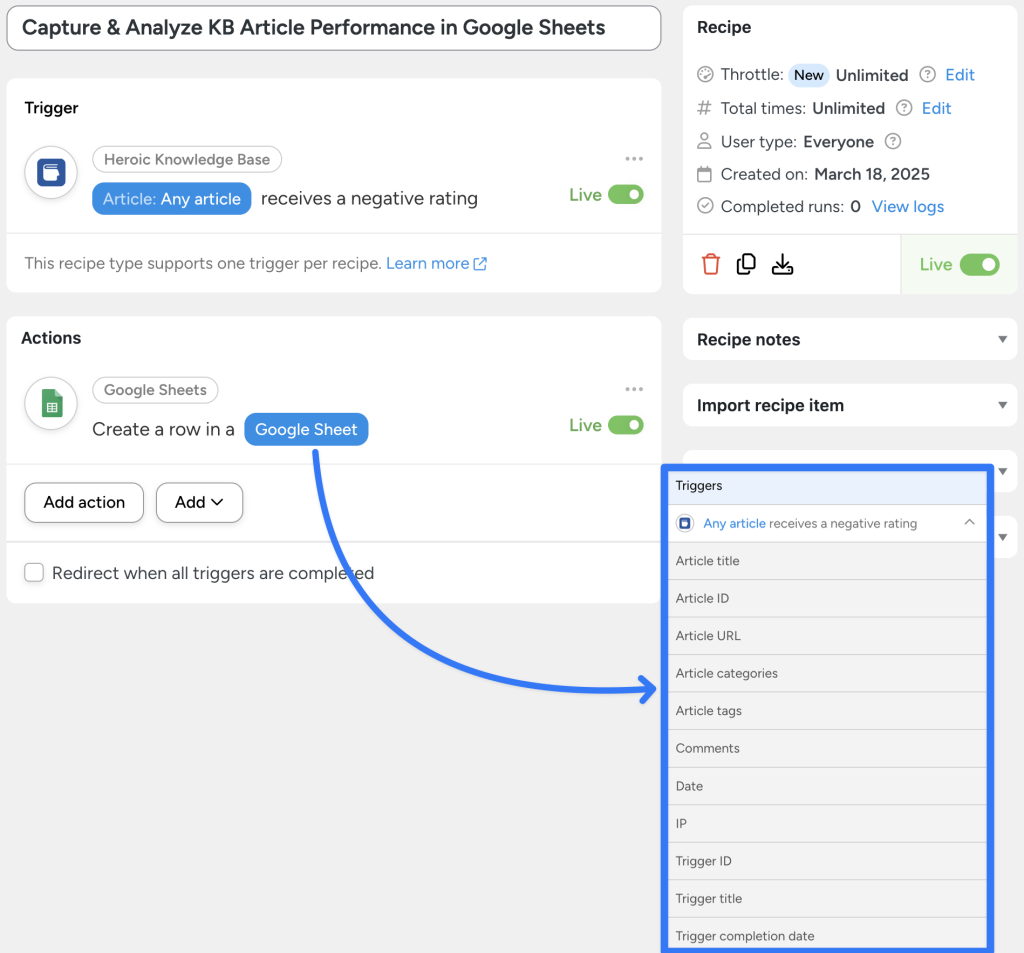

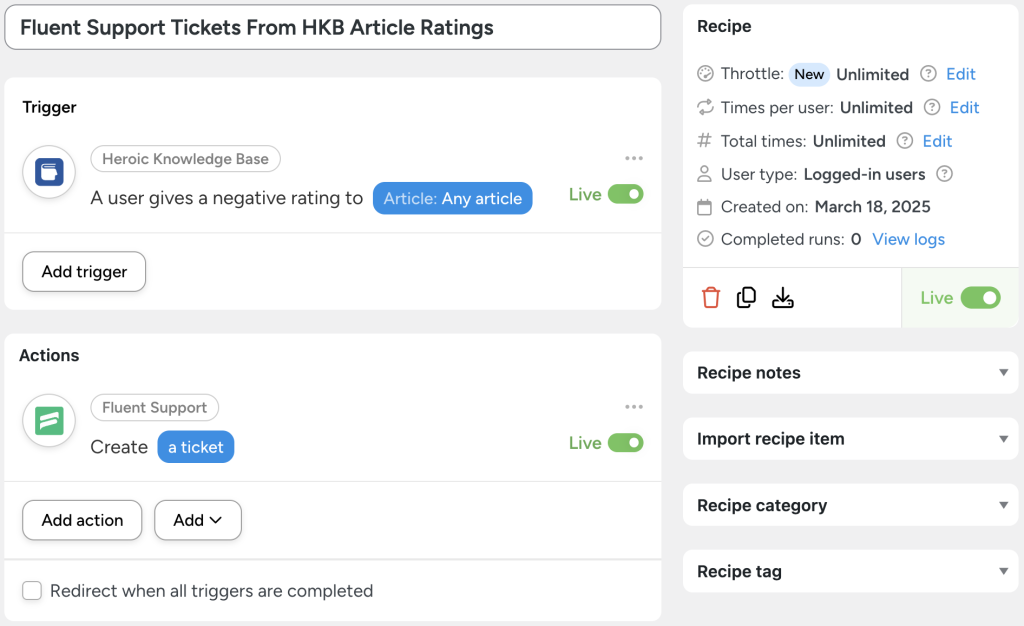
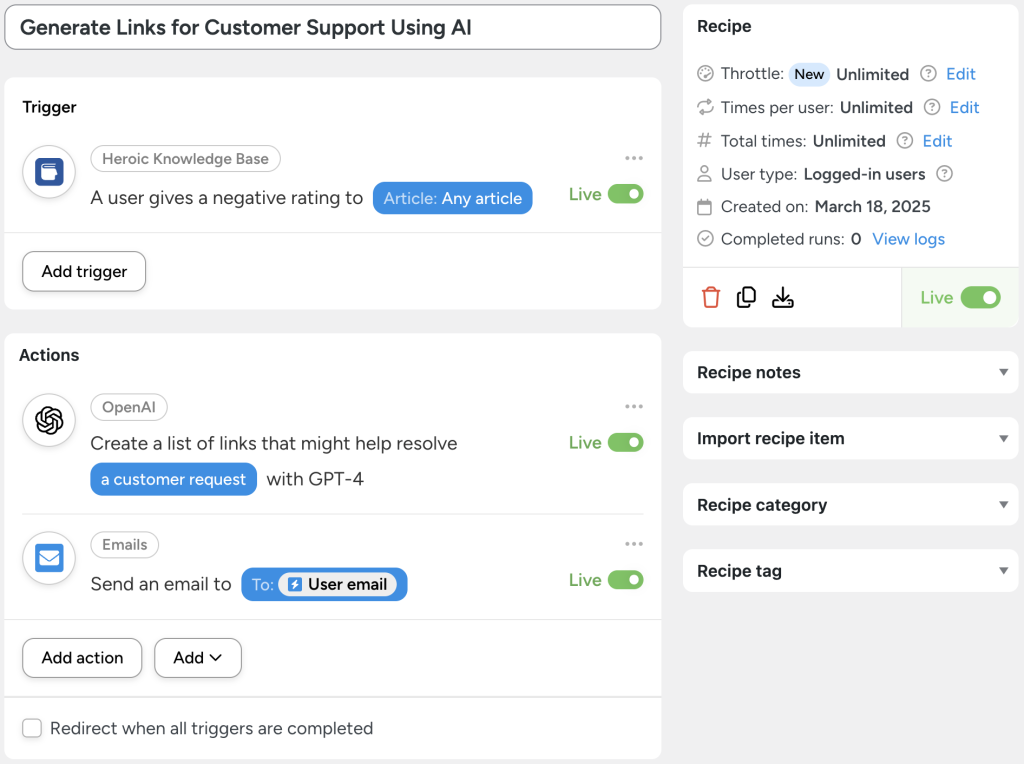
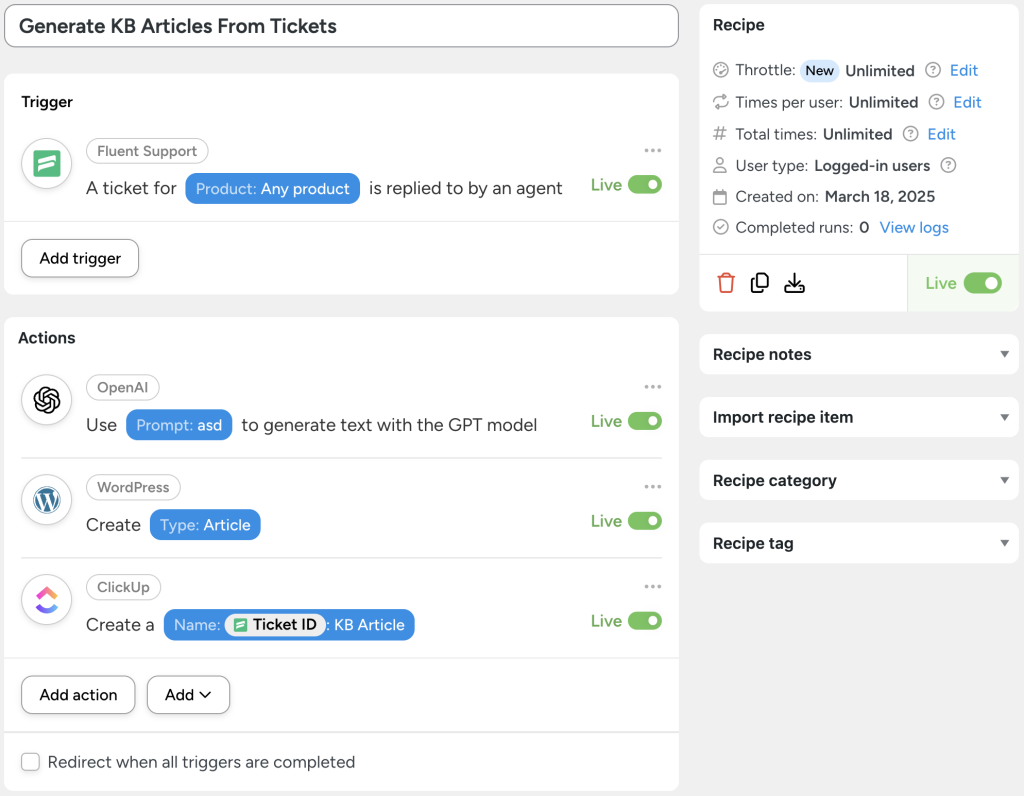




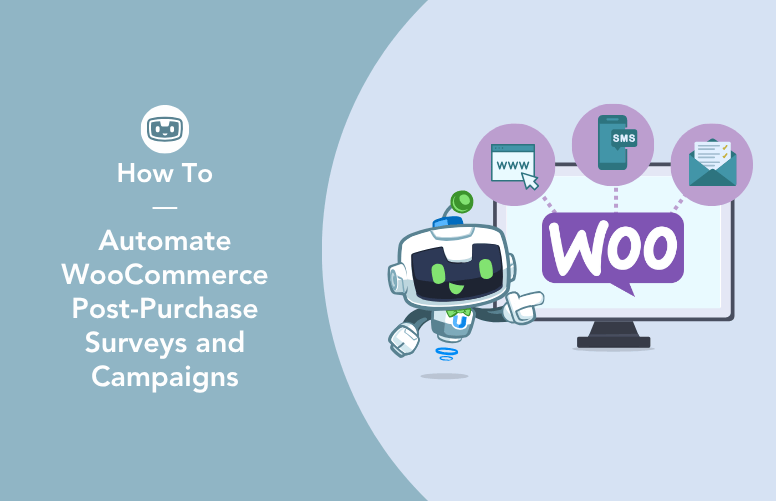
This Post Has 0 Comments